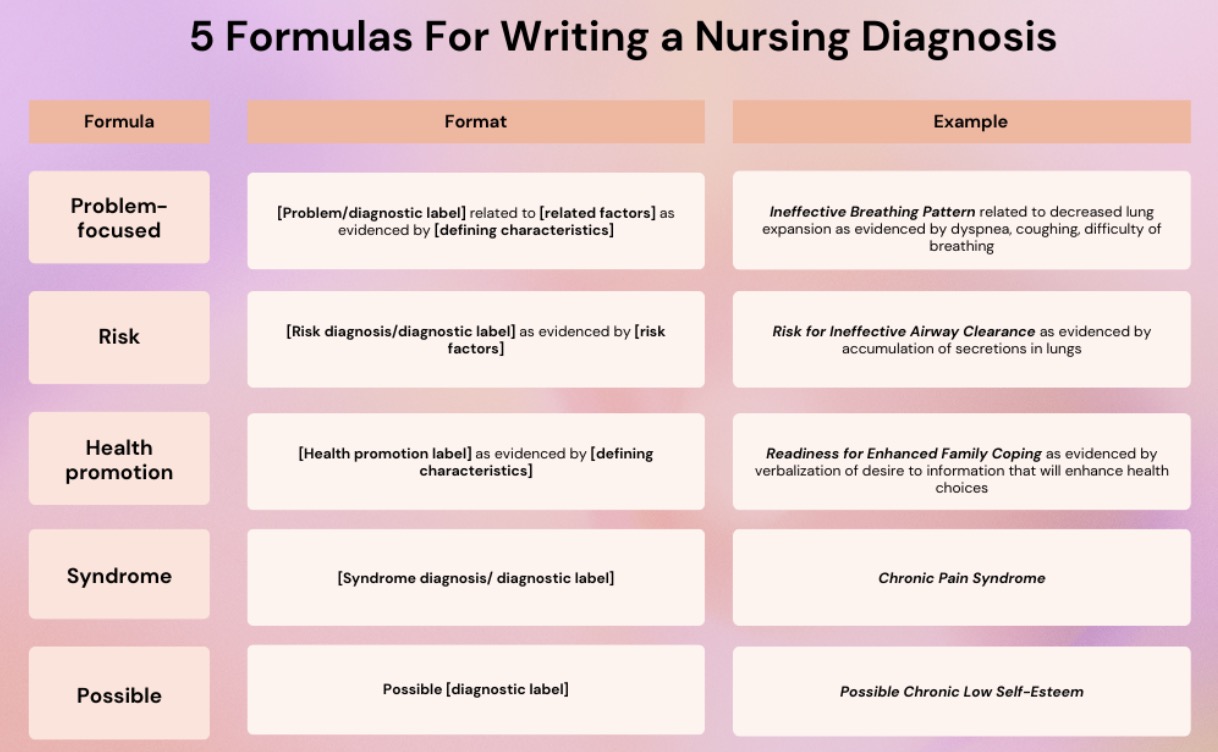When in nursing school, you’ll write a lot. You won’t only deal with standard writing assignments all college students practice. Apart from that, you’ll have specific tasks peculiar to medical specialists. Do you know they will ask you to write a nursing diagnosis? A lot!
The bad news is that writing a nursing diagnosis differs from writing a common college essay.
The good news is that below is your quick and easy guide on how to do that. Let’s learn a nursing diagnosis specifics and reveal the tips on writing it like a pro.
Reader's Roadmap
A Nursing Diagnosis: Definition
A nursing diagnosis is a judgment made by a medical specialist (a nurse) after a comprehensive assessment of a patient’s health status. It has three components: a problem statement, risk (related) factors, and defining characteristics. Based on that, a nurse writes a care plan they’ll evaluate after implementation by a patient and adjust it if necessary.
These diagnoses are integral to nursing because they provide high-quality, patient-centered care.
Writing a Nursing Diagnosis For Students
How do nursing diagnoses relate to students and the overall education niche? Professional essay writers from nursing paper writing service FastEssay explain:
Nursing students and those from medical colleges often get assignments to write a diagnosis. In classes, nursing papers become an effective teaching instrument to practice diagnosis writing and help future health professionals sharpen their critical thinking and problem-solving skills. In writing a nursing diagnosis, students learn to analyze symptoms, evaluate a patient’s response, and distinguish between subjective and objective data for identifying the problem and crafting a proper care plan.
FastEssay experts admit that many nursing students ask them to help with such writing assignments, which again demonstrates their necessity. After all, medical professionals should know diagnosis writing inside and out. The more they practice it in college or nursing school, the better.
How to Write a Nursing Diagnosis: 5 Tips

Below are your practical tips on writing a nursing diagnosis. It’s not a nursing essay in its usual sense, so the writing format and text structure here are different.
1) Collect and Analyze Symptoms
Before writing, you’ll need to observe a patient, take note of their symptoms, and analyze their overall condition. Craft a basic description, and don’t worry whether you use the official medical terminology at this stage. You’ll “translate” your notes later. Now, your task is to evaluate the patient’s response to pain and distinguish between subjective and objective data you get.
Subjective data is that from patients. They tell you how they feel, and it’s their perception, so you can’t verify it. Objective data is measurable, the one you can verify via scientific methods. Thus, dehydration and hypertension are accurate data, while patients saying they feel confused or dizzy are subjective.
2) Ensure It’s a Nursing, Not Medical Diagnosis
It’s critical to understand the difference between nursing and medical diagnoses:
A nursing diagnosis focuses on the patient’s response to an illness. For example, a nurse recognizes that a patient feels anxious, can’t sleep, or suffers from constipation. These problems are the patient’s response to some medical condition, so they refer to nursing diagnoses: anxiety, disturbed sleep, etc.
A medical diagnosis deals with diseases, conditions, and pathological states only physicians and advanced health care specialists can treat. These diagnoses lead to prescribing the proper medication that will cure the illness. For example, depression, diabetes, and obesity are medical, not nursing diagnoses.
So, look at the data you’ve gathered — and identify the problem. Use all the signs and symptoms to make a proper diagnosis.
3) Write an Outline for Your Diagnosis
A nursing diagnosis has five stages:
- Assessment
- Diagnosis itself
- Planning
- Implementation
- Evaluation
To write it, you’ll focus on the second one. Your diagnosis should be a concise statement demonstrating you understand the problem and have reasons to prescribe a particular care plan.
Outline your diagnosis using the AEB (“as evidenced by”) format. It’s a common nursing tactic to summarize the data and isolate characteristics demonstrating your diagnosed problem. The next step is to find the official terminology you’ll write down in your diagnosis. Use the NANDA-I (North American Nursing Diagnosis Association International) and other nursing textbooks to guide you.
4) Choose a Writing Format for Your Statement
Once you’ve decided on the final diagnosis, it’s time (finally!) to write it down. Do your best to use an exact writing formula to ascribe to the nursing profession standards. Proper formatting is critical here because it helps others in the medical field understand your diagnosis and prescribed interventions.
Below are five formulas you can use to write a nursing diagnosis.

Made in Canva
- Problem-focused. Use three components: a diagnostic label, related factors, and defining characteristics.
- Risk. Here, you write a diagnostic label with risk factors.
- Health promotion. Write a health promotion label and add “as evidenced by” with defining characteristics.
- Syndrome. Here, you write down an observed diagnostic label.
- Possible. Use it when you suspect the problem but don’t have enough information to confirm it.
Nursing students may also be asked to write the nursing care plan when assigned a diagnosis writing in college. The purpose is to help them practice implementing care plans, create measurable and achievable goals for their future patients, and develop evidence-based interventions.
If a care plan is part of your writing assignment, focus on ADPIE. (It’s the abbreviation for the above stages of a nursing diagnostic process: assessment, diagnosis, planning, implementation, and evaluation.) Ensure your care plan corresponds to each phase of the nursing process.
Prioritize nursing diagnoses based on the patient’s immediate needs and the urgency of interventions. Focus on addressing life-threatening issues first. Your plan should be specific and measurable, outlining the expected outcomes and timeframes for achieving them.
5) Re-Check It Twice!
The final stage is proofreading and editing your nursing diagnosis.
Before you submit it for review, ensure you haven’t misspelled any medical terminology or diagnostic label. Check the final draft for grammar and punctuation mistakes. (You can use corresponding tools like Grammarly, QuillBot, or ProWritingAid. All are available online, with all the primary features available for free.)
Also, check the format of your diagnosis one more time. Did you put every element in the proper place? Does everything sound clear, logical, and coherent? Didn’t you forget to use the AEB format? Re-read the final version of your nursing diagnosis twice: The first check is for content, and the second is for tiny elements like typos and overall design.
Final Words
Now that you know the core principles of writing a nursing diagnosis, why not practice it before you get a corresponding assignment in college?
Imagine a patient. Collect their symptoms, analyze them, identify related factors and a potential diagnosis, and make your clinical judgment. Write your nursing care plan: What would you recommend to your patient to improve their condition?







Leave a Reply
View Comments